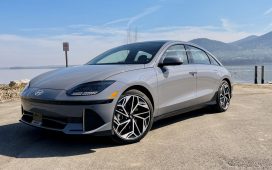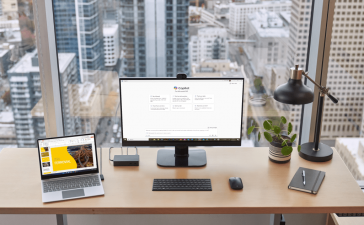General Motors’ next-generation Ultra Cruise driver-assist system will come equipped with lidar as well as several other high-tech sensors designed to enable hands-free driving and cover “95 percent” of driving maneuvers, the automaker announced today.
In its first major update since announcing Ultra Cruise in late 2021, the automaker outlined several of the sensors that will power the driver-assist system, including cameras, short- and long-range radar, and a lidar sensor. The vehicles will also come with an all-new computer to process the data input from the sensors, which the automaker previously indicated would include Qualcomm’s new Snapdragon Ride Platform.
The lidar will be located inside the vehicle, behind the windshield and under the rearview mirror
According to a pair of diagrams provided by GM, the lidar will be located inside the vehicle, behind the windshield and under the rearview mirror, where other automakers typically install sensors for advanced driver-assist systems (ADAS). Cameras can be found on the sideview mirrors, short-range radar in the lower corners of the grille and rear bumper, and long-range radars underneath the hood ornament and beneath the taillights.
“This will give us a 360-degree view around the vehicle to enable us to expand this hands free driving capability to these larger domains,” Jason Ditman, chief engineer at GM, told reporters in a briefing Monday. Ditman also said that drivers would be able to use Ultra Cruise “across nearly every paved road in the US and Canada.”
Lidar, a key ingredient in autonomous driving, is a laser sensor that uses near-infrared light to detect the shapes of objects. This helps autonomous vehicles “see” other objects on the road, like cars, pedestrians, and cyclists, all without the help of GPS or a network connection.
GM first announced Ultra Cruise during an investor event in 2021, describing it as a massive leap over the company’s Super Cruise system, which allows for hands-free driving on mapped divided highways. In contrast, Ultra Cruise will cover “95 percent” of driving scenarios on 2 million miles of roads in the US, the company said.
“This will give us a 360-degree view around the vehicle to enable us to expand this hands free driving capability to these larger domains”
Now we’re getting more of a glimpse — albeit an extremely limited one — into the types of sensors and hardware that will be included in these Ultra Cruise-equipped vehicles. GM has said that the bespoke ultra-luxury Cadillac Celestiq would be one of the first vehicles to come with Ultra Cruise — but that vehicle isn’t expected to go into production until early 2024. GM hasn’t said which additional models will be compatible with the driver-assist system.
Taken all together, these Ultra Cruise-equipped vehicles will be some of the most advanced cars ever produced by GM. The company is also developing the Ultra Cruise software in-house, using its own team of engineers and coders. Notably, the company is not partnering with Cruise, its robotaxi subsidiary, with Ditman calling the distinction between the two “unique.”
Despite its enhanced capabilities, GM says it still considers Ultra Cruise a Level 2 system, as defined by the Society of Automotive Engineers. At Level 2, the vehicle can control both steering and acceleration and deceleration as well as monitor blind spots and even change lanes automatically. But the driver needs to stay vigilant and keep their eyes on the road; if they don’t, the vehicle’s infrared sensors will detect it, and the system will send several warnings to the driver before disengaging.
Despite its enhanced capabilities, GM says it still considers Ultra Cruise a Level 2 system
Notably, that’s different from the Level 3 systems that Volvo, Mercedes-Benz, and Ford currently have under development. With a Level 3 system, a driver could theoretically take their eyes off the road under certain circumstances, like low-speed stop-and-go traffic.
That said, GM intends Ultra Cruise to be its answer to other current Level 2 systems, like Tesla’s Full Self-Driving beta system. Tesla CEO Elon Musk famously shuns the use of lidar to power his company’s partially autonomous features, calling the laser sensor prohibitively expensive and a “crutch.”
But as lidar costs fall, other automakers have embraced the hardware for its ability to render a 3D map of its environment and all nearby objects. In addition to GM, Volvo and Mercedes-Benz have recently announced their intention to include lidar in future production vehicles. And as Ditman put it, the decision to include lidar is less about money and more about safety.
“The choice of our sensor set was really not predicated around cost,” he said. “It was really predicated around what do we think is needed in order to safely deploy this type of technology.”
“The choice of our sensor set was really not predicated around cost.”
There is still a lot of research that needs to be done to fully investigate the safety claims made by automakers around ADAS features. There have been studies that show that the handoff between the automated system and a human driver can be especially fraught.
When people have been disconnected from driving for a longer period of time, they may overreact when suddenly taking control in an emergency situation. They may overcorrect steering, brake too hard, or be unable to respond correctly because they hadn’t been paying attention. And those actions can create a domino effect that has the potential to be dangerous — perhaps even fatal.
But Ditman argued that drivers need to feel confident, not complacent, about the ability of their vehicles to handle driving without their immediate input. “‘I’m not trying to drive complacency,” he said. “We addressed the inattentiveness with our driver attention system, so we don’t give you the opportunity to get complacent because if you do we’ll take the feature away from you.”











